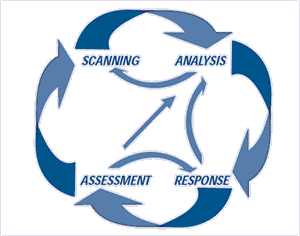Translations: Identificación y Definición de Problemas Policiales
Introduction
This Problem-Solving Tools guidebook deals with the process of identifying and defining policing problems. Under the most widely adopted police problem-solving model—the SARA (Scanning, Analysis, Response, Assessment) model—the process of identifying and defining policing problems is referred to as the Scanning phase. The Scanning phase is distinct from the Analysis phase, which principally is about explaining the problem’s causes and contributing factors; the Response phase, which is about developing, selecting, and implementing new responses to the problem; and the Assessment phase, which principally is about measuring the impact that new responses had on the problem.
The advice provided in this guidebook is based primarily upon theory and practice: there is no evaluative research into what methods most accurately and efficiently identify and define policing problems.
Figure 1. The SARA model of problem solving
Related Problem-Solving Tools Guides
This guidebook complements others in the Problem-Solving Tools series. The following other Problem-Solving Tools guidebooks address various aspects of these other three phases.*
* Some guidebooks address aspects of more than one phase of the problem-solving model.
Analysis Phase
- Researching a Problem (Guide No. 2)
- Using Offender Interviews to Inform Police Problem Solving (Guide No. 3)
- Analyzing Repeat Victimization (Guide No. 4)
- Partnering With Businesses to Address Public Safety Problems (Guide No. 5)
- Understanding Risky Facilities (Guide No. 6)
- Using Crime Prevention Through Environmental Design in Problem Solving (Guide No. 8)
- Enhancing the Problem-Solving Capacity of Crime Analysis Units (Guide No. 9)
- Analyzing and Responding to Repeat Offending (Guide No. 11)
- Understanding Theft of ‘Hot Products’ (Guide No. 12)
Response Phase
- Analyzing Repeat Victimization (Guide No. 4)
- Partnering With Businesses to Address Public Safety Problems (Guide No. 5)
- Understanding Risky Facilities (Guide No. 6)
- Implementing Responses to Problems (Guide No. 7)
- Using Crime Prevention Through Environmental Design in Problem Solving (Guide No. 8)
- Analyzing and Responding to Repeat Offending (Guide No. 11)
- Understanding Theft of ‘Hot Products’ (Guide No. 12)
Assessment Phase
- Assessing Responses to Problems: An Introduction for for Police Problem Solvers, 2nd Ed. (Guide No. 1)
- Analyzing Repeat Victimization (Guide No. 4)
- Using Crime Prevention Through Environmental Design in Problem Solving (Guide No. 8)
- Analyzing Crime Displacement and Diffusion (Guide No. 10)
- Analyzing and Responding to Repeat Offending (Guide No. 11)
- Understanding Theft of ‘Hot Products’ (Guide No. 12)

